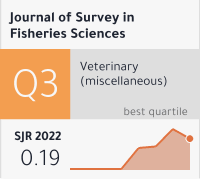Study On Prevalence of Helminth Parasite of Small Ruminant at Pishin Balochistan
DOI:
https://doi.org/10.53555/sfs.v11i4.3012Abstract
Helminthiasis is a significant issue in small ruminants, causing low productivity and financial losses. This study assessed the prevalence of helminth parasites in small ruminants in the Pishin district of Balochistan. A total of 400 fecal samples, 200 each from sheep and goats, were collected from each tehsil of Pishin and analyzed using direct, flotation, and sedimentation methods. The overall prevalence of helminths in small ruminants was 28.50%, with goats showing a slightly lower prevalence (26.50%) compared to sheep (30.50%). Prevalence varied among tehsils, with Barshore showing the highest (36.00%) and Saranan the lowest (21.00%). Infection rates were lower in males compared to females and varied by age, being highest in 1-2-year-old animals (46.2%). Haemonchus was the most prevalent helminth in both goats (64.15%) and sheep, followed by Trichostrongylus (22.65%) and Ostertagia (13.21%). Animals raised outdoors on free-range systems had a higher infection rate (35.20%) compared to those housed in cottages (30.40%) or cemented buildings (24.60%). Farmers primarily used Ivermectin (53.03%), Levamisole (28.40%), and Levamisole HCL (14.39%) for treatment, while a small percentage (4.16%) used the Neem plant. The study concludes that helminth infections are prevalent in small ruminants in Pishin, particularly in outdoor-reared animals. Effective management strategies, including proper housing and regular deworming with appropriate anthelmintics, are essential for controlling these infections and improving productivity in the region.









